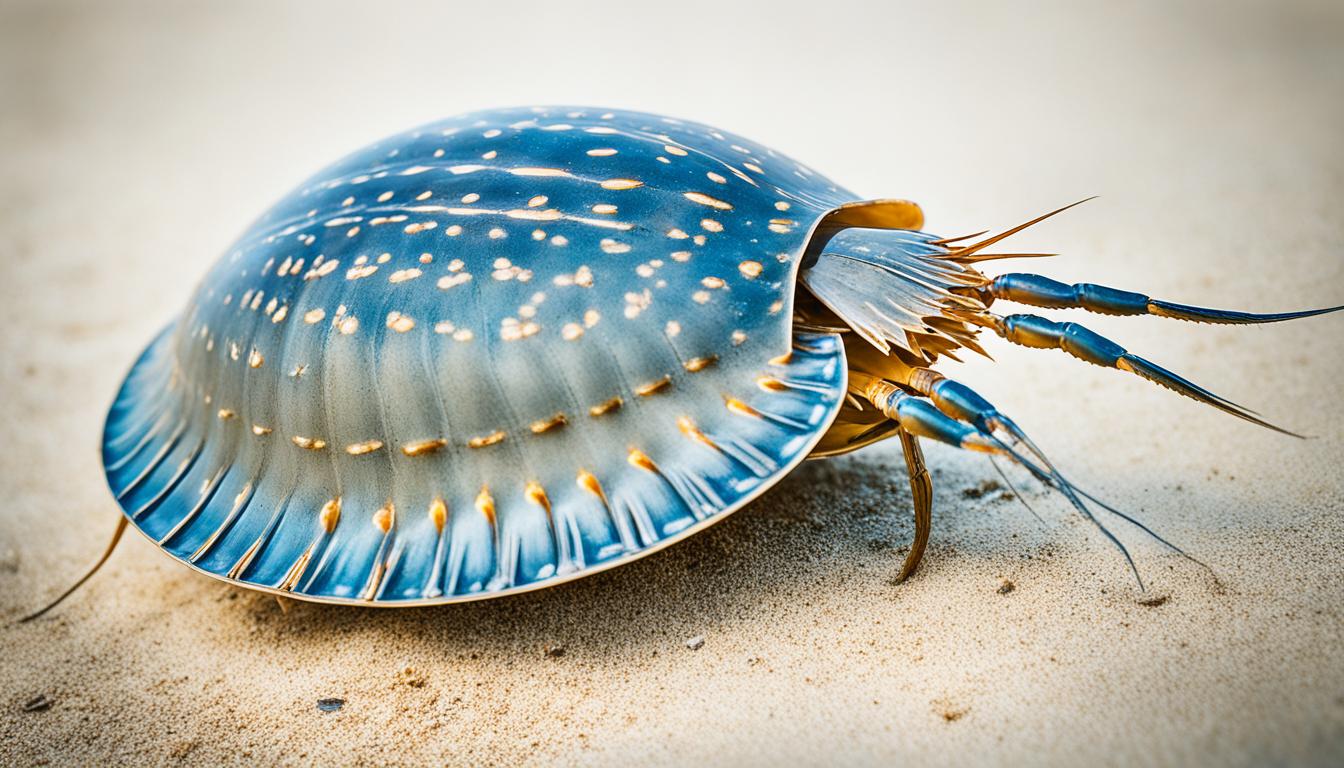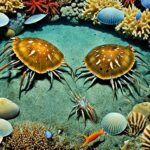Horseshoe crabs have been around for over 400 million years. They have unique ways of moving that help them in the ocean. These creatures are more like spiders and scorpions than true crabs, which affects how they move.
Their special body design lets them move in certain ways. These ways help them find food, lay eggs, and avoid predators. This shows how well they have adapted to survive.
Understanding Horseshoe Crab Anatomy
Horseshoe crabs stand out in the animal kingdom, unlike true crabs. Their horseshoe crab anatomy is unique, showing a special body design. This design includes key physical features that help us understand their survival and evolution.
Physical Features
Key horseshoe crab physical features include their helmet-shaped carapace and long tail, or telson. They have six pairs of appendages. Five pairs are legs for moving around, and the last pair, the chelicerae, is for eating. This setup lets them move and find food well.
They also have ten eyes—two compound and eight simple ones. This gives them great light sensitivity. Horseshoe crab joint movement is key for walking and crawling on the ocean floor. These movements help them find food and explore their home, showing their complex design.
How do horseshoe crabs move?
Horseshoe crabs move in unique ways, using both walking and crawling. They adapt their movements to fit their environment. This helps them move around for different tasks.
Locomotion Techniques
Horseshoe crabs move in various ways. They use their clawed legs to lift off the ground. This helps them move around easily.
For longer distances, they use their pusher legs to push forward. They can also quickly escape by expelling water from their gills. This “jetting” action lets them quickly move away from danger.
Walking and Crawling Behavior
On solid surfaces, horseshoe crabs walk in a slow and clumsy way. During breeding season, they crawl more, especially to reach the shore for spawning. They do this during high tides and with the help of lunar cycles.
This shows how these ancient creatures adapt and survive. Their behaviors are key to their survival.
| Behavior | Description | Environment |
|---|---|---|
| Walking | Deliberate movement using clawed legs for support. | Solid surfaces such as ocean floors or beaches. |
| Crawling | Low-to-the-ground movement, especially during breeding. | Shorelines during high tides. |
| Jetting | Rapid escape technique by expelling water. | Open water when threatened by predators. |
Swimming Abilities of Horseshoe Crabs
Horseshoe crabs have amazing swimming abilities that fit their special body shape. They can live in many types of ocean environments. When swimming, they often turn upside down, using their long tail as a rudder. This helps them move smoothly through the water.
This way of moving is key for avoiding predators and finding food. It’s also important for their survival during seasonal moves. They go from shallow areas to deeper waters, using their swimming and walking skills to adapt.

| Swimming Ability | Description |
|---|---|
| Inversion | Flips onto its back to enhance swimming efficiency. |
| Tail Rudder | Uses its tail for steering and stability while swimming. |
| Predator Evasion | Quick and agile movements help avoid threats in the water. |
| Feeding Search | Allows exploration of new areas for food sources. |
| Migration Skills | Facilitates long-distance travel to spawning habitats. |
Horseshoe Crab Navigation Methods
Horseshoe crabs need to navigate well in their water home, especially during the breeding season. Their horseshoe crab navigation methods are quite interesting. They use their advanced vision to move around. Their eyes have many ommatidia, helping them see changes in light and even how long the day is. This helps them know where they are.
When they move or search for food, horseshoe crabs use many cues from their environment. They can feel the changes in the tide and the moon’s phases. This helps them plan their moves perfectly. The moon’s cycles are key to their behavior, making sure they’re in the right spot at the right time.
Learning about how horseshoe crabs move and navigate shows how important they are to their ecosystems. They play a big role in keeping coastal areas healthy. As they adapt to new conditions, these amazing creatures keep being a key species to watch and learn from.
FAQ
How do horseshoe crabs move?
Horseshoe crabs move by walking and crawling. They use their clawed legs to lift themselves up. Then, they push themselves forward with their other legs. If they feel threatened, they can quickly move away by pushing water out of their gills.
What anatomical features assist in horseshoe crab locomotion?
Horseshoe crabs have a special body shape. They have a helmet-shaped shell, a long tail, and six pairs of legs. These legs help them move around. The way their joints move helps them walk, crawl, and even feed.
Do horseshoe crabs swim?
Yes, horseshoe crabs can swim. They flip over on their backs in the water. Then, they use their tail like a rudder to steer. This helps them avoid predators and find new places to eat.
How do horseshoe crabs navigate in their environment?
Horseshoe crabs use their ten eyes to see their surroundings. They can sense light and changes in the environment. This helps them know when it’s time to move for spawning or finding food.
What are the movement patterns of horseshoe crabs during spawning?
During spawning, horseshoe crabs crawl on beaches at high tide. They do this at specific times with the moon’s phases. This helps them breed successfully in coastal areas.







